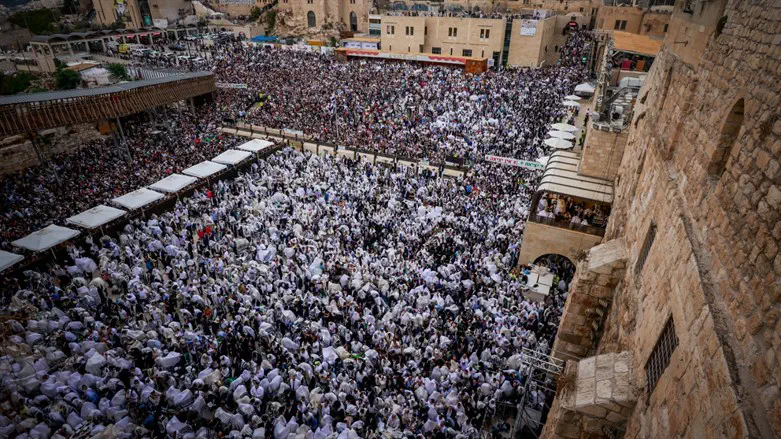
Another Yom Kippur has passed. Another. And a question we should ask ourselves is: How do we bring the essence of Yom Kippur into the rest of the year?
What should be plain is that the purpose of Yom Kippur (for both the individual as well as for Jewish People) is to come closer to G-d. The Jewish holidays---every one of them has this identical purpose and Yom Kippur is no different.
Yom Kippur has so many facets: How do we know which one to focus on as we begin 5784 and celebratee Sukkot that may deepen our relationship to G-d?
Next Year in Jerusalem!---the closing statement we make at the end of Yom Kippur, without a doubt, provides a possible path for us about this. Especially in our time.
The ancient rabbis who directed that "Next Year in Jerusalem!" be recited, and that it be specifically accompanied by a shofar blast, surely wanted us to focus on the permanent connection the Jewish People have with Jerusalem and the Temple Mount as we end our fast.
In reality this phrase is intended as "Next Year on the Temple Mount," where Yom Kippur offerings were made when the Holy Temples stood and will be made again upon the completion of the Third Temple. The reason we say "Next Year in Jerusalem!" at the conclusion of the Passover Seder is identical.
When we sing "Next Year in Jerusalem!" at the close of the Yom Kippur prayers the part of Jerusalem we are referring to here is what today's anti-Israel extremists deliberately call "East Jerusalem."
"East Jerusalem" does not actually exist and what they are really saying is that Jerusalem's Old City and its surrounding neighborhoods, where the Western Wall (Kotel) and the Temple Mount (Har HaBayit) are located, are not part of Israel or part of Israeli Jerusalem. The original and oldest parts of Jerusalem are what they falsely label "East Jerusalem'' and this is the Jerusalem, where the Holy Temple (Beit HaMikdash) stood, that the authors of the Machzor wanted us to yearn for and not the "New City'' which lies to the west. Every time we see "East Jerusalem" in the media we should note that it does not exist and never use the hateful term ourselves.
We should remember that in this period after Yom Kippur and throughout the year that the Temple Mount is solely the inheritance of the Jewish People and that our destiny lies on the Mount. Let's take a moment and strategize on how we can do this.
In the short term consider making the often overlooked "Farewell to the Sukkah" ceremony more consequential. Invite friends. Serve your favorite snack and when you recite "Next Year in Jerusalem!"---as the ancient rabbis directed that we do---talk about why we say it. After all, this is one of the three times of the year we say "Next Year in Jerusalem!" and yet we have the power to make its recitation much more impactful and not, G-d forbid, some afterthought. Make recitation this just as meaningful as when we sing "Next Year in Jerusalem!" at Passover and Yom Kippur.
Also, that Jerusalem and the Temple Mount are at the core of Sukkot is poetically recalled as such in the Hoshano titled "Even Sh’tiya." At Simchat Beit Hashoavah gatherings, and throughout the holiday, speak about these things. Add illustrations of the Beit HaMikdash to your Sukkah decorations.
There are times everywhere on the Jewish calendar designed to refocus our attention on the Temple and we should do so from Hannukah, to the Omer, and to the Three Weeks--let's make a point of starting with Sukkot and continuing on from there throughout 5784.
Our prayers also offer a consistent way to make the longing for the Temple a regular part of our day.
A final thought; seek ways to make the times that the liturgy contains prayers focused on the Temple (and there are many: from Ashrei to Birkat HaMazon and throughout the Siddur) more than an afterthought. Consider that too often when we get to the conclusion of Shemoneh Esrei / Amidah we may rush through the words and ideas. Don't. Savor this opportunity to connect to the Beit Hamikdash. The end of the Amidah is beautiful!
Take a fresh look at it:
"May it be Your will, L-rd, our G-d, and the G-d of our forefathers that the Holy Temple be rebuilt speedily in our days, and grant us our share in Your Torah. And there [in the Holy Temple] we will serve You reverently as in the days of old, and in former years. Then the offerings of Judah (Yehudah) and Jerusalem will be pleasing to the L-rd as in the days of old and in former years."
May 5784 be our last year without the Beit HaMikdash, please G-d.
Moshe Phillips, author and activist, previously a U.S. delegate to the World Zionist Congress.